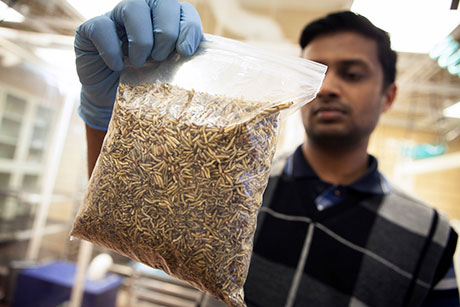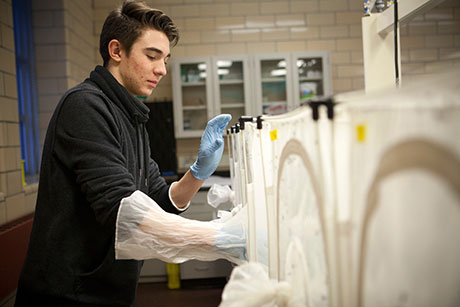Students assess commercial viability of larva meal
By Blaine Friedlander


With global meat consumption expected to climb 73 percent over current levels by 2050 and the appetite for seafood booming, Cornell graduate business students are looking further down the food chain to help meet the demand.
Three students in Cornell’s Samuel Curtis Johnson Graduate School of Management have examined the commercial viability of using housefly larva meal as a sustainable, less-expensive protein alternative to feeding stock and farm-raised fish.
Fish meal, a protein staple in the aquaculture industry, has become economically, socially and environmentally expensive, according to Sara Davis, Brent Filson and Trevor Wirsig. The students have developed a report for Cornell scientists exploring the issue.
To keep pace with meat production around the world, the feed industry is growing at a rate of 3.7 percent annually. Many stock animal feeds contain protein from fish meal, but housefly larva meal mirrors the nutritional content of fish meal, says Vimal Selvaraj, assistant professor of animal science and the principal investigator on an Atkinson Center for a Sustainable Future grant that examines how to make larva meal sustainable.
The Johnson students, under the guidance of Mark Milstein, clinical professor of management and director of the Center for Sustainable Global Enterprise, see potential in the larva meal business and suggested to Cornell agricultural scientists to focus on aquaculture as an initial market, locating production of larva meal near dairy farms (to obtain manure) and a warm climate for the houseflies.
To coax houseflies into hatching larvae, copious amounts of cow manure is needed on which the flies can lay their eggs. Millions of flies can reduce manure mass by half, concurrently lowering manure’s nitrogen and phosphorus content. Meanwhile, the larvae can be harvested as farm feed that is chock-full of protein and essential amino acids.
Protein of high biological value is essential to animal feed. Shortfall of quality protein resources like fish meal poses a future challenge for feeding livestock, said Selvaraj, “Larva meal is an ideal ingredient to replace fish meal with identical protein content and amino acid profile.”
Davis, Filson and Wirsig said the larvae production is scalable.
“In our process, larva meal is sustainably generated by regenerating protein from waste,” Selvaraj said. “This new approach to animal feed production can also make economic sense for commercial viability of a livestock enterprise.”
In addition to Selvaraj and Milstein, co-researchers on the Atkinson Center grant are Patricia Johnson, professor and chair of animal science, and Jan Nyrop, professor of entomology and senior associate dean of the College of Agriculture and Life Sciences.
Media Contact
Get Cornell news delivered right to your inbox.
Subscribe